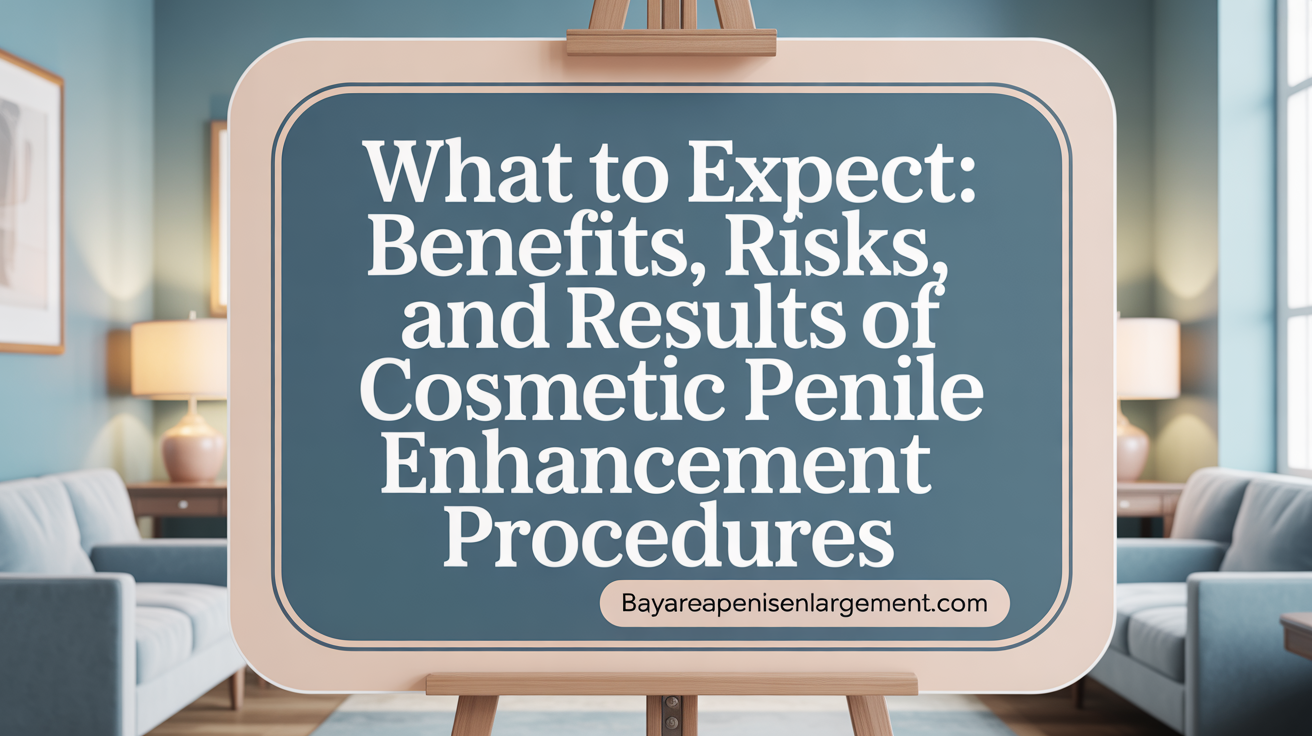Introduction to Penile Girth Enhancement
Penile girth enhancement has gained increasing attention in recent years as men seek ways to improve their sexual confidence, satisfaction, and self-image. This article explores the psychological and social motivations driving men to pursue these procedures, along with an in-depth examination of the medical and scientific aspects, available techniques, and the benefits and risks involved. Readers will gain a comprehensive understanding of why men choose to enhance penile girth and what to consider when exploring these options.
Psychological and Social Motivations Behind Penile Girth Enhancement

What psychological and social motivations lead men to consider penile girth enhancement?
Many men pursue penile girth enhancement to boost their self-confidence and improve their body image. Feelings of insecurity regarding their penile size often motivate them to seek cosmetic procedures. These motivations are intertwined with personal desires for aesthetic change, where men wish to alter the visual appearance of their penis to feel more satisfied.
In addition to aesthetic reasons, some men aim to enhance sexual pleasure and performance, believing that increased girth might lead to better intimacy and satisfaction for both partners. Medical concerns, such as correcting perceived deficiencies after prosthesis implants, also play a role.
Psychologically, a significant number of men seeking enhancement exhibit symptoms linked to penile dysmorphic disorder (PDD). Studies show approximately 11-14% of these men meet criteria for body dysmorphic disorder, highlighting underlying psychological distress and distorted perceptions of their penile size.
Lower self-esteem and dissatisfaction with one's body image are common among these individuals. Most men perceive their actual penis size as smaller than their ideal and expected outcome after augmentation, fueling their pursuit of procedures.
Ultimately, these motivations reflect a combination of internal dissatisfaction and societal perceptions emphasizing certain ideals of masculinity and penis size. The desire to fit these standards drives many men to seek both surgical and non-surgical enhancement options.
Medical and Scientific Factors Influencing Penile Girth Enhancement

What factors influence penile girth?
Penile girth is mainly shaped by genetic factors, which control tissue structure and growth. Variations in girth can also depend on ethnicity and overall body size, contributing to individual differences. Medical options, including surgical and non-surgical procedures, can modify girth but are generally pursued for health reasons or psychological concerns under professional supervision.
Societal and cultural influences also play a role, shaping perceptions of ideal size and impacting personal priorities regarding sexual health. Recognizing these natural differences helps promote body positivity and informed choices about enhancement options.
What is the preferred penile girth according to sexual partner preferences?
Research shows that the average erect penis girth is about 11.66 cm (4.59 inches). Studies also suggest that women tend to favor a girth of around 12.2 cm (4.8 inches) for long-term partners, which slightly exceeds the average.
Despite variations, most women prioritize girth over length for sexual satisfaction. Preferences tend to be consistent across populations, with many women valuing aspects of sexual compatibility over size itself. This indicates that most men’s concerns about girth align with what many partners find desirable.
| Parameter | Average Range | Note |
|---|---|---|
| Typical erect girth | 11.66 cm (4.59 inches) | Based on recent studies |
| Preference for girth | ~12.2 cm (4.8 inches) | Slightly above average |
| Flaccid girth | 9.31 cm (3.66 inches) | Variability among individuals |
Understanding these biological and psychological factors can help individuals make realistic and confident decisions concerning penile enhancement and sexual health.
Techniques and Procedures for Penile Girth Enhancement

What are the available surgical and nonsurgical techniques for penile girth enhancement?
Men seeking to increase their penile girth have a variety of options, which can be broadly classified into surgical and non-surgical methods.
Non-surgical approaches include the use of dermal fillers such as hyaluronic acid, polylactic acid, and polymethyl methacrylate (PMMA). These fillers are injected into the penile tissue to add volume, providing a temporary or semi-permanent increase in girth. For example, hyaluronic acid fillers like Restylane Sub-Q can achieve girth increases of approximately 0.25 to 0.5 inches per session, with effects lasting around 12 to 18 months. These procedures are minimally invasive, done in-office, and typically involve little downtime.
Other non-invasive methods include traction devices and vacuum therapy, which are aimed at gradually stretching the penile tissue or increasing blood flow. While these methods can produce modest girth gains over time, scientific evidence supporting their effectiveness is limited.
Surgical options tend to offer more significant results but come with higher risks. These include fat injections, where fat is harvested from other body areas and transferred to the penis, and tissue grafting using skin or other materials. Penile implants or devices like the Penuma implant can also enhance girth for suitable candidates. Surgical techniques might produce more predictable or substantial increases but are associated with risks such as fibrosis, infection, scarring, or dissatisfaction with cosmetic results.
Choosing the right method depends on individual goals, health status, and risk acceptance. Consulting with a qualified specialist is essential to determine the most appropriate and safe approach. Despite advancements, more research is necessary to conclusively establish long-term safety and effectiveness of these techniques.
Benefits, Risks, and Expected Outcomes of Penile Girth Enhancement

What are the benefits, risks, and expected outcomes associated with penile girth enhancement methods?
Penile girth enhancement procedures are increasingly popular among men seeking to improve their body image, confidence, and sexual satisfaction. Many of these procedures, particularly nonsurgical options like hyaluronic acid filler injections, offer significant advantages. Clients typically experience an increase in girth of around 0.25 to 2 inches, with immediate visible results. These treatments are minimally invasive, performed in-office, and usually take about 30 minutes, with little or no downtime. Benefits include enhanced sensation for both partners, improved self-esteem, and heightened sexual pleasure. Since hyaluronic acid is a substance naturally found in the human body, these injections are considered safe and can be reversed if desired. Results tend to last from six months up to two years, depending on the material used and the number of sessions.
On the other hand, surgical options such as fat transfer, penile implants, or grafting may produce more permanent results. These methods often involve anesthesia, longer recovery times, and higher risk profiles. Common risks include swelling, bruising, discomfort, scarring, and in some cases, loss of sensation or deformity in the penile tissue. Surgical procedures carry a higher potential for complications like infection or the need for reoperations.
Patients should have realistic expectations about the outcomes. While many experience significant girth increases and improved confidence, it is important to note that long-term safety data are still being collected. Additionally, improvements in size do not necessarily correlate with increases in sexual satisfaction for all individuals. Open communication with a qualified and experienced provider can help tailor treatment plans and minimize risks.
In summary, penile girth enhancement offers a variety of benefits such as increased size, confidence, and pleasure, with manageable risks mainly related to temporary swelling and minor discomfort. The longevity of results varies by method, with non-surgical treatments generally lasting from several months to two years, and surgical options providing more enduring outcomes, although at the cost of higher procedural risks.
Effectiveness, Safety, and Misconceptions of Penile Girth Enhancement Options
How effective, safe, and suitable are natural versus medical procedures for increasing penile girth?
Natural procedures aimed at increasing penile girth, such as platelet-rich plasma (PRP) injections, are minimally invasive and considered safe for most men. They work by stimulating tissue growth naturally, which can lead to modest increases in girth and improved confidence. However, their results are typically subtle and may require multiple treatments.
Medical procedures, including injections with hyaluronic acid (HA), polylactic acid (PLA), or polymethyl methacrylate (PMMA), have been shown to produce significant girth gains. On average, these methods can increase girth by around 2 to 3.8 centimeters, with most patients experiencing immediate results. These procedures are generally safe when performed by qualified professionals, with minor side effects such as swelling, bruising, or nodularity that resolve quickly.
Surgical options like fat transfer, grafts, or penile implants tend to offer more permanent results. Yet, they carry higher risks such as infection, scarring, deformity, and unpredictable outcomes. Patients considering surgery must weigh the benefits against potential complications, and long-term satisfaction can vary.
Non-invasive devices like traction and vacuum pumps usually do not produce long-term girth increases. They might offer slight length improvements and psychological benefits, but their effectiveness for girth enhancement remains limited.
Overall, minimally invasive and injectable procedures can be effective and relatively safe for suitable candidates. However, the choice depends on individual goals, health status, and expectations, emphasizing the importance of consulting a healthcare professional.
What common misconceptions exist about penile girth enhancement options such as fillers and medical treatments?
Many misconceptions surround penile girth enhancement, often fueled by exaggerated marketing or lack of proper understanding. One prevalent myth is that fillers and treatments like dermal injections or surgical implants provide instant or permanent results. In reality, most non-surgical options like hyaluronic acid fillers offer immediate benefits but are temporary, typically lasting between 6 to 18 months. Maintenance through repeat treatments is often needed to sustain the desired size.
Another false belief is that these procedures are highly risky or irreversible. Actually, non-surgical methods—especially hyaluronic acid injections—are considered very safe, performed under local anesthesia with minimal discomfort. They are reversible, with hyaluronic acid being dissolvable if necessary.
People also assume that exercises, devices, or supplements can produce substantial, lasting girth increases quickly. Scientific evidence does not support these claims; gradual and realistic improvements are more achievable through professional procedures.
Ultimately, understanding that results require time, proper technique, and realistic expectations is crucial. Seeking treatment with qualified practitioners ensures safe, effective outcomes built on accurate information.
How long do nonsurgical penile girth enhancements typically last?
The effects of nonsurgical penile girth enhancement treatments, including dermal fillers and fat transfer, generally last between 6 to 18 months. Hyaluronic acid fillers tend to provide noticeable girth increases shortly after the procedure, with most of the volume dissipating gradually over time. Touch-up treatments are often recommended annually to maintain the results.
Fat transfer procedures may offer slightly longer-lasting benefits, but some amount of reduction in girth can occur in the first few months as the body reabsorbs some of the transferred fat. Nonetheless, with proper technique and care, many men enjoy sustained improvements for up to a year or more.
It's important for patients to understand that these treatments are temporary, and regular maintenance or retreatment might be necessary for ongoing satisfaction. Consulting a qualified specialist helps determine the most suitable approach and set realistic expectations regarding duration and outcomes.
Conclusion: Informed Choices and Realistic Expectations
Penile girth enhancement reflects a complex interplay of psychological, social, and medical factors motivating men to seek improved self-confidence and sexual satisfaction. Advances in minimally invasive procedures, particularly the use of hyaluronic acid and other fillers, offer effective and relatively safe options with immediate, natural-looking results and minimal downtime. Nonetheless, potential candidates must weigh the benefits against risks, recognize the temporariness of many nonsurgical options, and maintain realistic expectations. Consulting qualified healthcare providers is essential to ensure personalized care and optimal outcomes. Ultimately, penile girth enhancement should be approached thoughtfully, prioritizing both physical health and psychological well-being.
References
- What Are the Benefits of Penile Girth Enhancement?
- Motivations and Psychological Characteristics of Men Seeking ...
- Is Penile Girth Enhancement Right for You? | NaturallYou CT and FL
- How Penile Girth Enhancement Can Improve Sexual Relationships
- Do Natural Approaches For Increasing Penile Girth Work? | Himplant®
- Penile Girth Enhancement for Men with Penile Prostheses
- BellaFill Penile Girth Enhancement in Boston, MA | Dr. Shektman
- Penile Girth Enhancement — LA Male Fertility, Sex Med, Men's Health

